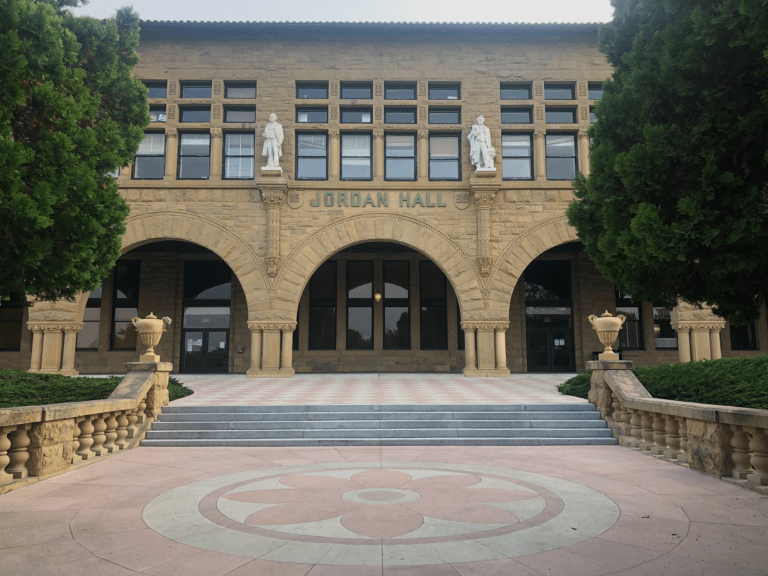Stanford will remove the name of David Starr Jordan, the University’s first president and a prominent eugenicist, from campus spaces, Board of Trustees Chair Jeff Raikes ’80 announced on Thursday. President Marc Tessier-Lavigne endorsed the move, which began with a recommendation from a committee that reviewed requests from the psychology department and Stanford Eugenics History Project, and was approved by the Board of Trustees.
Raikes said that “there are really better ways to acknowledge Jordan’s true contributions to Stanford while also addressing the more challenging dimensions of his legacy.”
“Because of David Starr Jordan’s prominence in the promotion of eugenics and significant involvement in the American eugenics movement during his tenure as the first president of Stanford University,” the committee wrote in its recommendation, “we believe that continuing to honor him in locations where community members work or study will undermine Stanford’s values.”
Jordan Hall is currently home to the psychology department. Raikes called the department’s residence in the building “ironic,” adding that the department, “which is a pioneer in studies of stereotype threat, belonging and implicit bias, is based in a building name for an individual who espoused that the efficacy of education is limited by one’s genetic potential.”
Law professor Bernadette Meyler J.D. ’03, who chaired the recommendation committee, praised the decision made by Tessier-Lavigne and the Board.
“By choosing the path of renaming, Stanford has reaffirmed its commitment to rendering campus inclusive for all community members,” she wrote in a statement to The Daily.
Meyler also wrote that the committee’s report calls for a more complete telling of Jordan’s history.
“Recognizing that naming is a blunt instrument, the Report suggests a menu of other options that the University could adopt to tell a fuller story about David Starr Jordan.”
Debra Satz, dean of the School of Humanities and Sciences, will be responsible for creating a process to determine a new name for Jordan Hall, which will temporarily be referred to as Building 420. Satz wrote in an email to The Daily that she expects to have a list of names to present to Tessier-Lavigne by the end of winter quarter.
Tessier-Lavigne will be responsible for renaming other spaces on campus that bear Jordan’s name including Jordan Quad and Jordan Modulars. The committee also recommended that the renaming of Jordan Way, a street on the School of Medicine’s campus, “may take place during the course of ongoing construction and planning.”
The committee also recommended the relocation of a statue of Louis Agassiz, Jordan’s mentor who has no significant ties to the University, from the facade of the hall.
“Retaining the statue of Louis Agassiz, who advocated against Black equality, would also damage Stanford’s efforts to ensure equity and inclusion,” the renaming committee wrote in its recommendation. A location for the statue of Agassiz has not yet been chosen, according to Raikes.
“We also believe that it is important to continue to display the statue of Louis Agassiz somewhere on campus in an appropriate context, in light of the statue’s iconographic prominence in Stanford’s history.”
Ben Maldonado ’20, a leader of the Eugenics at Stanford History Project was pleased by the trustees’ decision.
“It’s great to see the Stanford community start to reckon with this part of the University’s history,” Maldonado — who also wrote the series “Eugenics on the Farm” for The Daily’s Opinions section — wrote in a statement to The Daily.
“I hope this reckoning with eugenics and scientific racism continues through both educational measures and university policy, such as through the departmentalization of African and African American Studies and the allotment of resources to scholars and students who study these fields,” he added. “Renaming is an excellent start, but it should not be the end of the conversation.”
Jordan, the founding president of Stanford University, is known for guiding the University out of a major financial crisis. He also handled the aftermath of the 1906 earthquake. “With the Stanfords,” Raikes said, “he shaped much of the character and orientation of the University in its founding years.”
The committee recognized several faculty members and their “ongoing efforts to foreground aspects of Jordan’s history and involvement with eugenics.”
One such faculty member is Steven Roberts, who teaches “PSYCH 1: Introduction to Psychology.”
“As our nation reckons with a racist history, and a racist present, Stanford has shown that it is committed to an anti-racist future. I could not be more proud,” Roberts wrote in a statement to The Daily.
Before serving as the University’s first president, Jordan served as the president of the Indiana University whose Board of Trustees voted on Friday to also remove his name from sites on their Bloomington campus.
This article has been updated with statements from Bernadette Meyler, Ben Maldonado, Steven Roberts and information from Debra Satz.
An earlier version of this article incorrectly referred to Indiana University as the University of Indiana. The Daily regrets this error.
Contact Michael Espinosa at mesp ’at’ stanford.edu and Benjamin Zaidel at bzaidel ‘at’ stanford.edu.
